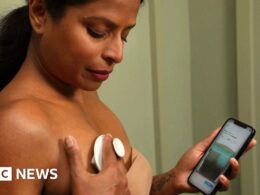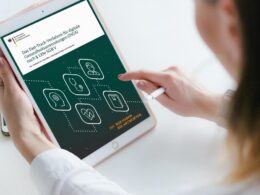Health Transformation Institute (HTI)
Joaquim Cardoso MSc*
Chief Researcher and Editor
November 7, 2022
*MSc from London Business School — MIT Sloan Masters Program
Source:
By Lisa Vura-Weis, Kazim Zaidi, Ben Shaffer, Jonathan Scott, Jonathan Lim, Yoonjin Min-Morrison
October 2022
Executive Summary:
What is the context?
- The COVID-19 pandemic accelerated a shift to digital engagement in health care, including expansion of telehealth, growth of digital outreach, information, and communication, and an increase in mobile apps for health management.
- The authors conducted a survey from May through June 2022 of 465 insured adults to evaluate how consumer sentiment toward digital health has changed, and how consumers want to be engaged moving forward.
What are the findings of the survey?
- The findings debunk outdated views that Medicaid members do not have internet access, that they are not digitally savvy, and that they do not want to engage with their payers and providers in digital ways.
- In fact, the data show striking similarities in the preferences for digital engagement across Medicaid and commercially insured members.
- Both groups
(1) have an increased appetite for telehealth (especially for behavioral health care),
(2) want to shift from in-person and phone to digital channels to seek information and engagement with their provider or payer, and
(3) are interested in apps to help manage their health.
- The survey also found that Medicaid members are digitally underserved (that is, they are not offered the same level of digital engagement as their commercially insured counterparts).
What are the implications? What are the benefits?
- These findings imply that Medicaid-managed care organizations (MCOs) and providers that serve Medicaid patients should prioritize digital engagement :
(1) to improve care navigation,
(2) provide information,
(3) reduce cost to serve and free up time for more valuable activities, and
(4) keep beneficiary information up to date as eligibility changes.
- There is opportunity for MCOs and providers to not only lower their own costs but also improve care and increase member or patient engagement and loyalty by expanding use of these underutilized channels.
What is the role of Medicaid agencies?
Medicaid state agencies also have an important role to play:
- pushing their MCO and provider partners to offer the same digital engagement opportunities as they offer their commercial members.
- Medicaid agencies can achieve this by raising the bar on digital engagement in their MCO procurements.
Infographic
Exhibit 1 — Medicaid and Commercial respondents have access to internet in their homes; most Medicaid respondents have smartphones, all Commercial respondents do

Exhibit 2–59% of Medicaid respondents use mobile banking daily, signaling an ability to perform complex transactions on a mobile device

Exhibit 3 — Medicaid respondents value digital capabilities almost as much as commercial, with respondents slightly more ‘neutral’ toward digital capabilities

Exhibit 4 — Medicaid respondents are less satisfied with an online platform/ app especially with respect to insurance coverage, claims, and bill pay

Exhibit 5–41% of Medicaid and 35% of Commercial members have not been offered any health apps by payer

Exhibit 6 — Those who utilized apps were generally satisfied, but opportunities exist to cater to Medicaid members using weight, prescription management, and diabetes apps

Exhibit 7 — Medicaid respondents have a slight preference for in-person visits, although preference across respondents is lower for in-person behavioral health

Exhibit 8 — Medicaid | Desire to shift from in-person and phone to web and app across all activities

Exhibit 9 — Commercial | Relatively lower desire to move from in-person and phone to web and app compared with Medicaid users

Exhibit 10 — Lack of interest and cost are cited as reasons for low adoption (cost may be driving lack of interest); there is high interest in health & fitness tracking


ORIGINAL PUBLICATION (full version)

Reaching Medicaid Members Where They Are: Online and On Their Smartphones
Source:
By Lisa Vura-Weis, Kazim Zaidi, Ben Shaffer, Jonathan Scott, Jonathan Lim, Yoonjin Min-Morrison
October 2022
Introduction
The COVID-19 pandemic accelerated a shift to digital engagement in health care, including expansion of telehealth, growth of digital outreach, information, and communication, and an increase in mobile apps for health management.
The COVID-19 pandemic accelerated a shift to digital engagement in health care, including expansion of telehealth, growth of digital outreach, information, and communication, and an increase in mobile apps for health management.
We conducted a survey from May through June 2022 of 465 insured adults to evaluate how consumer sentiment toward digital health has changed, and how consumers want to be engaged moving forward.
We specifically sought to understand how the experiences and preferences of Medicaid members, who have traditionally been viewed as digitally naive or disinterested, differ from those of commercially insured members.
Our findings debunk outdated views that Medicaid members do not have internet access, that they are not digitally savvy, and that they do not want to engage with their payers and providers in digital ways.
We conducted a survey from May through June 2022 of 465 insured adults to evaluate how consumer sentiment toward digital health has changed, and how consumers want to be engaged moving forward.
Our findings debunk outdated views that Medicaid members do not have internet access, that they are not digitally savvy, and that they do not want to engage with their payers and providers in digital ways.
In fact, the data show striking similarities in the preferences for digital engagement across Medicaid and commercially insured members.
Both groups have an increased appetite for telehealth (especially for behavioral health care), want to shift from in-person and phone to digital channels to seek information and engagement with their provider or payer, and are interested in apps to help manage their health.
We also found that Medicaid members are digitally underserved (that is, they are not offered the same level of digital engagement as their commercially insured counterparts).
In fact, the data show striking similarities in the preferences for digital engagement across Medicaid and commercially insured members.
Both groups have an increased appetite for telehealth (especially for behavioral health care), want to shift from in-person and phone to digital channels to seek information and engagement with their provider or payer, and are interested in apps to help manage their health.
These findings imply that Medicaid-managed care organizations (MCOs) and providers that serve Medicaid patients should prioritize digital engagement …
… to improve care navigation, provide information, reduce cost to serve and free up time for more valuable activities, and keep beneficiary information up to date as eligibility changes.
We believe there is opportunity for MCOs and providers to not only lower their own costs but also improve care and increase member or patient engagement and loyalty by expanding use of these underutilized channels.
These findings imply that Medicaid-managed care organizations (MCOs) and providers that serve Medicaid patients should prioritize digital engagement …
… to improve care navigation, provide information, reduce cost to serve and free up time for more valuable activities, and keep beneficiary information up to date as eligibility changes.
Medicaid state agencies also have an important role to play:
pushing their MCO and provider partners to offer the same digital engagement opportunities as they offer their commercial members.
Medicaid agencies can achieve this by raising the bar on digital engagement in their MCO procurements.
As we approach the eventual end of the public health emergency (PHE), and the Centers for Medicare & Medicaid Services proposes new rules to address churn, Medicaid agencies can also think about how to use these channels to engage members with their MCO and provider partners.
Medicaid state agencies also have an important role to play: pushing their MCO and provider partners to offer the same digital engagement opportunities as they offer their commercial members.

Medicaid Members: A Misunderstood Demographic
Are Medicaid members digitally naive or digitally savvy?
Based on historical rates of internet access and smartphone ownership by low-income individuals, an assumption exists that Medicaid members do not have consistent access to digital channels, and that those who do are not digitally savvy.
To the contrary, our survey found that 91% of Medicaid member respondents had internet either in or out of their home (for example, on a phone or at a library), while 9% had internet access both in and out of their home (see Exhibit 1).
Exhibit 1 — Medicaid and Commercial respondents have access to internet in their homes; most Medicaid respondents have smartphones, all Commercial respondents do

Source: Medicaid is n=251 and Commercial is n=214 unless otherwise specified.
When asked which devices they use to access the internet, 96% of Medicaid members said they use their smartphone, vastly outpacing the second device selected — only 56% of Medicaid members reported using a laptop to access the internet.[1]
While there is no question a digital divide exists across income levels and geographies, a large majority of respondents across payer types noted regular use of mobile apps.
When it comes to social media and communication apps like YouTube, Facebook, e-mail, or text, Medicaid members are regular users (89%, 87%, 82%, and 74%, respectively).
Eighty-six percent of Medicaid members use mobile banking at least weekly, signaling an ability to perform more complex or sensitive transactions on a mobile device, as well as an interest in doing so (see Exhibit 2).
Exhibit 2–59% of Medicaid respondents use mobile banking daily, signaling an ability to perform complex transactions on a mobile device

Source: Medicaid is n=251 and Commercial is n=214 unless otherwise specified
Medicaid members clearly want and are equipped to engage with brands and perform daily tasks through digital channels.
Medicaid members are digitally savvy, and they want health care platforms to know and serve them.

Payer Interaction
Medicaid members want and are able to engage digitally, and this extends to interactions with their health plan.
Members are less satisfied, however, with their digital offerings than those with commercial insurance are.
When asked whether digital capabilities were important when choosing an insurance provider, the majority of Medicaid and commercially insured members agreed that being able to engage digitally to view insurance coverage information like claims, access health management apps, and engage with payer representatives and providers is important.
While commercially insured members agreed at slightly higher rates on the importance of digital interaction, the similarities in sentiment across commercial and Medicaid members are striking (see exhibit 3).
Exhibit 3 — Medicaid respondents value digital capabilities almost as much as commercial, with respondents slightly more ‘neutral’ toward digital capabilities

Source: Medicaid is n=251 and Commercial is n=214 unless otherwise specified.
When considering satisfaction with current health plan platforms or apps, however, Medicaid members are not satisfied at equal rates to commercially insured members with their health plan’s online platform.
For example, while 83% of commercially insured members are satisfied or highly satisfied with their ability to understand what services were covered online, only 72% of Medicaid members were.
Across similar questions, Medicaid members were consistently less satisfied on average (see exhibit 4).
Exhibit 4 — Medicaid respondents are less satisfied with an online platform/ app especially with respect to insurance coverage, claims, and bill pay

Source: Medicaid is n=251 and Commercial is n=214 unless otherwise specified.
Medicaid members were also offered health management apps by their MCOs at lower rates than commercially insured members were by their health plans.
Forty-one percent of Medicaid members and 35% of commercially insured members had not been offered any health apps by their plan (see exhibit 5), despite generally high satisfaction among Medicaid and commercial members who did utilize apps.
Exhibit 5–41% of Medicaid and 35% of Commercial members have not been offered any health apps by payer

Source: Medicaid is n=251 and Commercial is n=214 unless otherwise specified.
Satisfaction among Medicaid members who utilized health apps was high, but survey results show room for improvement, particularly for weight tracking or weight loss, prescription management or reminder, and diabetes management apps (see exhibit 6).
Exhibit 6 — Those who utilized apps were generally satisfied, but opportunities exist to cater to Medicaid members using weight, prescription management, and diabetes apps

Source: Medicaid is n=251 and Commercial is n=214 unless otherwise specified
For payers, there is a clear opportunity to leverage the types of apps they already offer in their commercial lines to members in their Medicaid lines.
Medicaid members are digitally savvy, and they want health care platforms to know and serve them

Provider Interaction
We also sought to understand how digital interaction and preferences with providers differed across Medicaid and commercially insured populations.
Nearly 30% of both Medicaid and commercially insured respondents indicated a preference for telehealth for primary care visits — rates much higher than pre-pandemic and current estimates of actual virtual care visits.
Consistent with other research, the interest in virtual behavioral health visits was even greater, with more than 40% of respondents preferring virtual behavioral health care (see exhibit 7).
Exhibit 7 — Medicaid respondents have a slight preference for in-person visits, although preference across respondents is lower for in-person behavioral health

Source: Medicaid is n=251 and Commercial is n=214 unless otherwise specified.
For Medicaid members, satisfaction across in-person and virtual visits was similar, though there was a slight preference for the comfort provided by an in-person provider — Medicaid respondents prioritized provider engagement and short travel time when asked what makes a positive experience with a care provider.
While in-person care remains the preference of a majority of respondents, both Medicaid and commercially insured members expressed a strong desire to shift from in-person and phone to digital channels for routine administrative tasks with their providers.
For example, only 44% of Medicaid members used a digital channel to request or view their medical history in the past two years, while 59% would prefer to use a digital channel in the future.
While commercially insured members also expressed a desire to use digital channels more frequently, the increase is not nearly as pronounced.
In our sample, Medicaid members expressed using digital channels over the past two years significantly less than commercially insured members (see Exhibit 8 and 9).
Exhibit 8 — Medicaid | Desire to shift from in-person and phone to web and app across all activities

Source: Medicaid is n=251 and Commercial is n=214 unless otherwise specified.
Exhibit 9 — Commercial | Relatively lower desire to move from in-person and phone to web and app compared with Medicaid users

Source: Medicaid is n=251 and Commercial is n=214 unless otherwise specified.
We hypothesize that this is because Medicaid members are not offered digital avenues as frequently as commercially insured members are.
This may be because they are less likely to be served by providers that do not have the ability to invest to the same extent as larger systems that cater to the commercially insured.

Use of Tech Tools for Health
Despite Medicaid members’ interest in interfacing digitally with health care platforms and apps for administrative tasks and telehealth provider visits, members have low or infrequent adoption of additional health management application offerings (for example, mental health, activity tracking, or disease management apps).
Forty-one percent of Medicaid members reported never having used an app to manage health, compared with 27% of commercially insured respondents.
When asked why they did not use a device or app to monitor health, Medicaid members cited lack of interest and cost as the main barriers, although 49% said they would use a device to monitor health issues like blood sugar level, respiration, blood oxygen, and heart rate if it was provided to them (see exhibit 10).
Exhibit 10 — Lack of interest and cost are cited as reasons for low adoption (cost may be driving lack of interest); there is high interest in health & fitness tracking


Source: Medicaid is n=251 and Commercial is n=214 unless otherwise specified.
Given Medicaid members’ digital capabilities and interest in engaging with apps, health plans and providers should consider offering apps and devices that have proved effective with their commercially insured populations.

Implications and Recommendations for Payers, Providers, and Medicaid Agencies
Our survey findings show there is a gap between existing digital options available and how Medicaid members want to interact with their MCOs and providers.
While in-person visits will remain critical, by improving or developing digital options for Medicaid members, health plans and providers can improve engagement, patient care, and care management and navigation.
In doing so, both payers and providers can communicate with members or patients in a lower-cost way, freeing up time and cost for more valuable activities amid provider and health care worker shortages.
We see significant opportunity for MCOs, providers, and Medicaid state agencies to learn from our findings.
Payers
Payers can both reduce administrative costs and improve care for Medicaid members with smart expansion of digital engagement.
Many MCOs already offer or are required by states to offer care management and navigation or other services that could be improved by expansion of digital offerings.
Most Medicaid members are aware of their insurance provider and if given the option will likely choose their existing insurance provider as a commercial consumer, especially if existing plan satisfaction scores are high.
With a strong, standardized digital offering, payers have an opportunity to reduce consumer attrition, capture additional data through apps, and reduce administrative costs (for example, reduce walk-ins or call centers in favor of self-service digital applications).
MCOs should:
- Improve information accessibility: Develop digital channels for understanding benefits, specifically focused on in-network provider options, referrals, and potential copays service coverage.
- Integrate digital in care management: Develop care management and disease management mobile solutions to go along with disease-specific interventions tied to specific outcomes and value-based payments (for example, vaccination reminders or well-child visit reminders that can help improve Healthcare Effectiveness Data and Information Set [HEDIS] scores).
- Utilize already built offerings: Provide and promote products currently available to commercially insured members to Medicaid members (for example, if a mental health app is available to a payer’s commercial clients, it should also be available to Medicaid members).
Providers
Providers are stretched to provide quality care amid increasing demand; shortages of clinicians, nurses, and other healthcare workers, especially in primary care, behavioral health, and home health; and increasing administrative demands and complexity.
Digital channels have been shown in commercial insurance and outside of health care to be a lower-cost and reliable form of communication, that over time can reduce administrative burden as it is incorporated into workflows.
In health care, giving patients the ability to understand their options and navigate care digitally can help improve outcomes.
Investing in digital tools can help providers differentiate themselves in the market and gain competitive edge through:
- Lower administrative costs. If patients are able to manage their own scheduling, medical records access, and vaccination information, the burden of service is reduced for the provider and the care team.
- Higher retention. As the network becomes easier to use through automated appointment reminders, streamlining of referrals, and online prescription refills, Medicaid members are incentivized to remain within the provider system.
- Continued focus on preventative care. The utilization of prescription reminders, chronic care treatments, and even specialist referrals continues to put the patient at the center of their care.
- Innovation and experimentation: Recognize the willingness of Medicaid members to try monitoring devices if they are provided free of cost and seek partnerships to provide devices to patients as part of care management pilots.
MEDICAID AGENCIES
Our research suggests that Medicaid members are not receiving the kind of digital engagement they desire, with potential negative consequences to cost, retention, and health outcomes.
With the need for continued engagement with members at the end of the PHE, Medicaid agencies should be asking their private partners to think beyond traditional service.
To capitalize on the growing interest in digital channels, Medicaid agencies should:
- In their plans for the end of the PHE, partner with MCOs and providers with their own digital channels to market upcoming deadlines for renewal or to report any changes.
- Expand mobile offerings. Integrated eligibility and enrollment systems were meant to help promote new kinds of usability and access. Work with technology vendors to expand mobile uses of integrated eligibility systems and reminders.
- Push partners to use digital. With many states utilizing MCOs for care management and expecting MCOs to help providers address health outcomes, the importance of understanding your MCOs’ digital offerings to members or to providers is increasingly important. Use contract levers for engagement and expectations for care management to push for more engagement.

About the Research
BACKGROUND
This article is based on data drawn from an online survey of consumers that was conducted in 2022 across a representative sample in the United States.
The goal of the research is to provide our clients and health insurance providers with information on shifts in trends and Medicaid member sentiment to inform product offerings and decision making that improve health care for Medicaid members.
A team composed of BCG consultants and experts completed the survey analytics.
TIMING
From May 26, 2022, to June 13, 2022, 465 Medicaid and commercial insurance holders responded to a survey about their past health insurance experiences and future preferences.
DEMOGRAPHICS
Seventy percent of respondents were between the ages of 25 and 66. Fifty-six percent of respondents were female. Sixty-eighty percent identified as White/Caucasian; 21% identified as Black/African American; 1.5% identified as American Indian, Alaska Native, Native Hawaiian, or other Pacific Islander; and 5% identified as other race or multiracial. Fifteen percent identified as Hispanic or Latinx. Forty-three percent were from the South, 22% from the Midwest, 19% from the Northeast, and 15% from the West. Fifty-seven percent had a total annual household income before taxes of less than $50,000, 21% between $50,000 and $74,999, and 22% more than $75,000.













